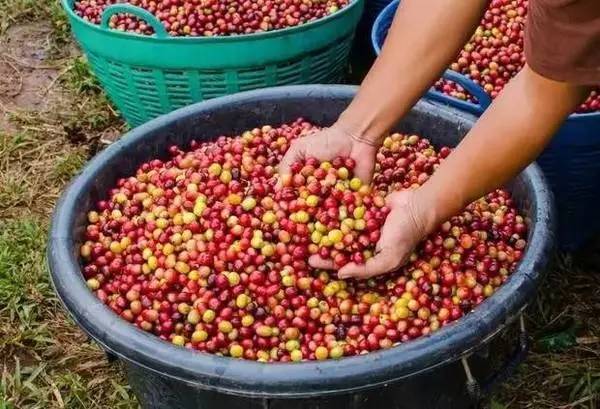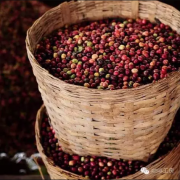Ethiopia's pride-Yegashefi coffee has a wide variety, rich flavor and charming aroma.

For professional baristas, please follow the coffee workshop (Wechat official account cafe_style)
Ethiopia is a country full of wonders. What we say here, the Arabica coffee we have never drunk comes from this.
Nearly 2000 coffee varieties have been recorded in Ethiopia, including 1927 native varieties and 128 imported varieties. So just by looking at the appearance, Esther's coffee variety is "Grand View Garden", which has everything, long, short, thin, fat.
Long particles are found in all coffee growing areas in Ethiopia. From the actual proportion seen, there are more long particles in the western Jimma, including Limmu and Kaffa, and less in sidama (Sidamo) or yirgacheffe (Yega Sheffield).
Small granule species, the shape is relatively round, the bean body is very small, mostly between 14-15 orders, this species should be the most familiar to us. They are often seen in Sidamo and Yegashiri, and I have seen them in a harrar sample, as well as in raw coffee beans sold locally in Jimma, compared to other areas. There are many native varieties of this kind of small particles in sidama, yigracheffe and surrounding arsi and guji.
In addition to the wide variety of coffee, the way coffee is grown also affects the variety mix of Ethiopian coffee beans.
Ethiopia's coffee cultivation is divided into:
● forest coffee forest coffee (8-10%), coffee trees and other crops coexist in the primeval forest, without any artificial care, farmers will pick coffee fruits regularly.
● forest-semi-forest coffee semi-forest coffee (30-35%), the coffee planting area is between the forest and the range of farmers' lives, coffee trees are naturally produced varieties like forest coffee, and farmers will manage coffee planting areas and grow other cash crops.
● pastoral coffee garden coffee (50-55%), coffee trees are planted around farmers' living areas, and most of them are grown by farmers themselves.
● plantation coffee plantation coffee (5-6%), a large private grower, has more treatment facilities and production capacity.
Most of the coffee cultivation in Sidamo and Yega Xuefei belongs to the pastoral coffee model, in which coffee farmers plant coffee trees near their living areas and harvest them during the harvest season. it is then sent to a nearby treatment plant built on water for unified treatment (or purchased by a middleman). In addition to a small number of plantations that have the strength to grow, pick and handle raw coffee beans independently, many coffee beans from different regions and varieties will be centrally processed by the processing plant and then sent to the auction house for official evaluation and grading. This is one of the reasons why many Ethiopian coffee beans are named after processing plants or cooperatives, and it is also one of the reasons why the same batch of coffee beans are mixed with multiple coffee varieties. even the flavor of different batches of coffee beans produced by the same treatment plant will be significantly different.
Country: Ethiopia
Grade: G1
Producing area: Yejia Xuefei
Baking degree: shallow baking
Treatment: washing
Variety: native species
Flavor: Jasmine, lemon, bergamot, honey, black tea
Cochel is located in a small producing area 25 kilometers southeast of Yegashafi, Ethiopia. It is a rich area for coffee production. It is also one of the three famous and micro-producing areas of Yegashafi. It has about 100,000 local residents, and coffee beans are the main source of income. The processing and processing equipment of this production area is very advanced. Coffee Review, a well-known coffee evaluation website, gave Kocher a high rating of 94 points for washed beans.
There are eight main coffee producing areas in Ethiopia: Nekempte (Lekempti) Gimbi Kinby, Limulim, Illubabor Ibedo, Djimma Gima, Harrar Hara, Teppi/Bebeka Bebeca, Sidamo Sidamo, Yirgacheffe Yega Chefe, among which the more well-known boutique coffee producing areas
Nekempte (Lekempti), Limu, Harrar, Sidamo and Yirgacheffe,Yirgacheffe are located in the Sidama district of Ethiopia in Africa, so it can be seen that Yirgacheffe belongs to a smaller region in the Sidama producing area.
Yejaschuffe itself is a small town of about 20, 000 people, and the three neighboring producing areas, Wenago, Kochere and Gelena Abaya, are also classified as Yejasuffe because they produce coffee with almost the same flavor as Yejasuffe. Yejacheffe is similar to the neighboring Sidamo in terms of culture and geography, but it seems to be more favored to enjoy the advantageous conditions, top-quality Yega Chefe coffee with floral aromas, bright citrus acidity, lemon flavours and silky taste.
Kochere Cochel is located in southwestern Ethiopia, 25 miles north of the famous town of Yega Chefen. The production model is based on local small farmers sending output batches to cooperatives for unified processing. The local Chalalacktu village has about 100000 people who depend on coffee for a living, and related production activities have become their main source of income. Due to the benefits brought by coffee production, the local living standard is much better than that in many Ethiopian villages, with sound health facilities, colleges and universities, and so on. Advanced processing equipment makes the coffee in the Kochere area always have a high level of performance in the field of washing treatment, with the clean and sweet complex flavors of molasses and citrus.
Important Notice :
前街咖啡 FrontStreet Coffee has moved to new addredd:
FrontStreet Coffee Address: 315,Donghua East Road,GuangZhou
Tel:020 38364473
- Prev

What is the authentic Yega flavor? What are the flavor characteristics of the really excellent Yejasuffi coffee beans?
For professional baristas, please pay attention to the coffee workshop (Wechat official account cafe_style). Sun Yega Chefe coffee beans will have a distinct dry aroma of red wine, while washed Yejiachefi coffee beans are citrus honey fruit aromas: clean and delicate aromas, floral, vanilla, peach, honey, sucrose wet fragrance: vanilla plant
- Next

The reason for the charming flavor of Yega Xuefei: unique coffee planting pattern and Ethiopian native species
Communication of professional baristas Please pay attention to coffee workshop (Wechat official account cafe_style) Esse coffee cultivation is divided according to scale and model: ● forest coffee forest coffee (8-10%), coffee trees and other crops coexist in the primeval forest, without any manual care, farmers will pick coffee fruits regularly. ● Forest-half Forest Coffee semi-forest coff
Related
- Does Rose Summer choose Blue, Green or Red? Detailed explanation of Rose Summer Coffee plots and Classification in Panamanian Jade Manor
- What is the difference between the origin, producing area, processing plant, cooperative and manor of coffee beans?
- How fine does the espresso powder fit? how to grind the espresso?
- Sca coffee roasting degree color card coffee roasting degree 8 roasting color values what do you mean?
- The practice of lattes: how to make lattes at home
- Introduction to Indonesian Fine Coffee beans-- Java Coffee producing area of Indonesian Arabica Coffee
- How much will the flavor of light and medium roasted rose summer be expressed? What baking level is rose summer suitable for?
- Introduction to the characteristics of washing, sun-drying or wet-planing coffee commonly used in Mantenin, Indonesia
- Price characteristics of Arabica Coffee Bean Starbucks introduction to Manning Coffee Bean Taste producing area Variety Manor
- What is the authentic Yega flavor? What are the flavor characteristics of the really excellent Yejasuffi coffee beans?

